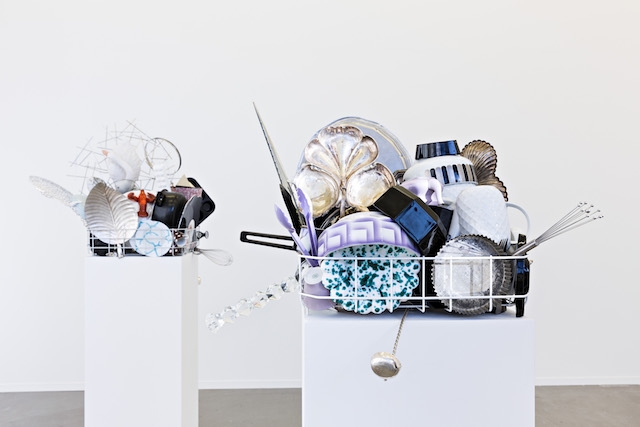Nicole Wermers achieves her cleverly comedic art by turning the familiar on its head – sometimes literally. At least this is the case with the early video Palisades (1998/2017), which features handheld footage of conference and shopping centres presented upside down. The simple inversion renders the structures unrecognisable, surprising, somewhat silly. Following suit, her first survey exhibition is a humorously subversive journey through the sombre, and often masculine, authority of commercial, professional and public spaces.
Mood Board #2 and #3 (2016), a pair of baby-changing stations, extend the journey to the restroom. In the gallery this setup, which normally anticipates being soiled by human offspring, looks like a display shelf, but what is on show is a savvy parental trick: faux terracotta flooring, beloved for its ability to hide dirt, might here serve the same function, Wermers proposes. Another brilliant lifehack, Double Sandtable (2007) is a large table of the type that you might find in an office meeting room; covered in sand and littered with cigarettes, though, it spares everyone the nuisance of reaching for the ashtray or, worse, breaking up the gathering. These works, together with The Long Hello (2017), a 20m stretch of adjacent doormats, transform throwaway moments or socially liminal spaces into primary events.
Collectively such gestures work to undermine a gender dynamic that tends to devalue what is traditionally considered women’s work (such as changing nappies and taking on domestic responsibilities) by upending normative assumptions of womanhood. Wermers’s Dishwashing Sculptures (2013–7) – half arte povera, half Baroque still life – seem the outcome of a mad challenge to balance as many items of kitchenware on the drying rack as possible; one teetering pile includes a porcelain lobster. Meanwhile, Earring (2006), grotesque in size and pinned to the wall, is a cross between an invertebrate sea creature and a single testicle, and Untitled Chairs (2015–7) infuses the modernist ethos with a strong measure of female camp, as fur coats are installed as backrests for Marcel Breuer’s famous Cesca design.
Several works perform similar domestic interventions on twentieth-century culture, deftly projecting the everyday battle between the sexes onto the male-dominated history of modern art and design. A case in point, Vertical Awnings (2016): these six upright, rolled-up terrace awnings in candy-coloured stripes, the exhibition text tells us, parody the sky-high ambitions of Constantin Brancusi’s Endless Column. Opposite, some 20 photo-collages, Croissants and Architecture (2016–17), pair one photograph of the French delicacy after another with a monochrome sheet of sandpaper within the same frame. As if a hilariously more palatable variant of Bernd and Hilla Becher’s tireless quest for photographic objectivity, the puff pastry becomes with each iteration more absurd, and its connotative relation to the sandpaper, given Wermers’s customary gender-games, more convoluted.
Above and besides all this, croissant-yellow, it turns out, looks great with matt sandpaper-grey and awning-burgundy. Beauty, the argument seems to go, doesn’t have to justify itself by high-flown conceptual pretences.
Nicole Wermers: Women Between Buildings at Kunstverein in Hamburg, 3 March – 6 May
From the May 2018 issue of ArtReview
